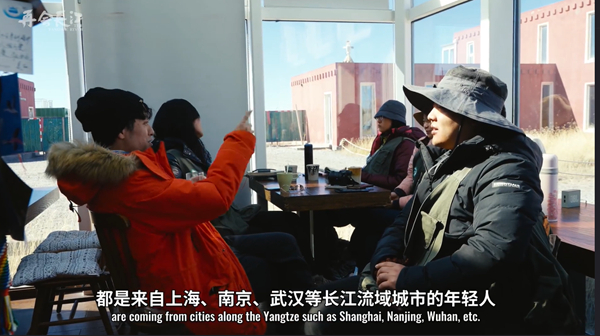Japanese director releases episode of Yangtze River documentary

Japanese filmmaker Ryo Takeuchi takes a walk along the Tuotuo River, a source of the Yangtze River, in Northwest China's Qinghai Province.
The first episode of a new documentary on the Yangtze River by Japanese director Ryo Takeuchi has won wide attention on video platforms.
The episode “Searching for the First Drop of Water” features a truck driver, young volunteers at the Tuotuo River, and Tibetans living by the glaciers. No posing and no fuss. It takes a candid look at the very moment of their daily life.
Back in 2011, Ryo Takeuchi participated in the filming of a documentary about the longest Chinese river for NHK, Japan's public broadcaster. After moving to live in Nanjing in 2013, he always hoped to film the river again as he has developed new insights into Chinese people’s life and different customs, which he feels is regrettably missing in the NHK documentary.
For the new production of the 6,300 km river, he went all the way to the Tuotuo River, a source of the Yangtze River, in Northwest China's Qinghai Province, to record how the glacier melts and forms the “first drops of water of the Yangtze”.
The four members also travelled extensively to Yunnan, Sichuan, Chongqing, Hunan, Hubei, Jiangxi, Anhui and Jiangsu, and Shanghai where the river reaches the East China Sea.

Ryo Takeuchi (L) and truck driver Li Wu
On the Qinghai-Tibet Plateau, the team talked with the locals and gained a lot of valuable information for the documentary’s production. They hitched a ride in a truck along the Qinghai-Tibet Highway, one of the highest highways in the world, and met truck driver Li Wu.
Li introduced the great changes over the years. He said people in Tibet can also buy online, which was quite unimaginable in the past. He’s also proud that the journey from Chengdu to Lhasa took about one week before 2017 and now it’s just 60 hours.
The director said the biggest difficulty with this filming was his loss of physical stamina compared with over ten years ago. At the place with an elevation of over 4,700 meters, he had a very severe altitude sickness and the shooting was stopped for a while. When filming the glacier melting, his colleague followed him while carrying an oxygen tank, so the progress was slow.
In Takeuchi’s memory, the infrastructure around the Tuotuo River ten years ago was in a shabby condition. The road was bumpy, and there were only few small hostels. Today, the former site of the first bridge at the Tuotuo River has become a cultural relic under the provincial protection. He’s also happy to find the new road, more vehicles and hotels thriving in the area.
But the trip to Kekexili was not without disappointments. The team met an organization dedicated to the protection of endangered animals and learned about their routine efforts to persuade tourists not to feed Tibetan antelopes. Unfortunately, the team had to give up the story at last because they failed to capture any footage of the endangered species during the stay.

Young volunteers along the Tuotuo River
What has left Takeuchi a deep impression is an environmental protection organization with members mostly born in 1990s. Young people from various cities along the Yangtze River work as volunteers at the Tuotuo River, who encourage visitors to exchange rubbish for souvenirs. The members also do research on garbage sorting, report the information to producers, and call for efforts of using environmentally friendly materials.
With this documentary, the director is keen to see, record and share changes along the river after over ten years and also reflect the customs and people’s real life in straightforward ways.